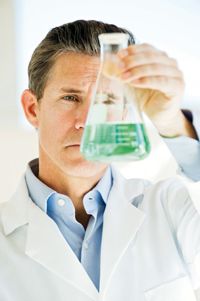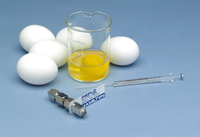
CRM
Can you trust your buffer solution?
Can you trust your buffer solution?
GMP, GLP, ISO 9001, EN 45000, Calibration, Verification, Traceability, and Certification from an accredited organization: Key words those are increasingly important. The calibration of pH and Redox electrodes has never been easy. All calibration procedures assume that the labelled values of the calibration buffers are correct. But buffer values can change over time and so can your results
A complete range of patented buffer solutions provides never before achieved pH stability. Hamilton guarantees DURACAL pH buffers for 5 years after the date of manufacture. The pH 9.21 and pH 10.01 buffers are even stable in air. See the diagram below for details. High buffering capacity provides rapid, stable calibration. Preservatives are added to prevent microbial and mold growth.
Traceability
An important issue for the production of Certified Reference Material is to ensure the traceability through an unbroken chain of comparisons to reference material of the highest metrological quality (Primary Reference Material).
- Closed Loop Traceability: Unlike other manufacturers where only a top-down traceability is applied, Hamilton is working with circular or closed loop traceability. The closed loop traceability ensures the users of Hamilton DURACAL buffer a unique reliability!
- Top-down traceability: At Hamilton, the pH value of DURACAL buffers is determined by comparison against two Secondary Reference Buffer Solutions. These are purchased from accredited suppliers for Secondary Reference Materials. The solutions themselves are compared against Primary Reference Solutions from PTB1) or NIST 2).
- Bottom-up traceability: To ensure the highest possible accuracy and full reliability of the pH value, a representative number of samples from every single production lot is sent to a German DKD3) laboratory (DKD-K-06901) for an external, independent and impartial verification. In this laboratory, the DURACAL samples are compared against Secondary Reference Solutions from DKD-K-06901.
- The Secondary Reference Solutions are of course compared against Primary Reference Solutions from PTB. At this stage, the loop is closed: the PTB Primary Reference Solution is the starting and ending point of the traceability loop. DKD provides Hamilton with a calibration certificate for every DURACAL production lot.
Minimum sample intake
 Every material is heterogeneous. The minimum sample intake is an amount of material that is representative of the whole unit (vial, bottle, jar etc.). The certified value and its uncertainty cannot be guaranteed for subsamples smaller than the minimum sample intake. Some manufacturers include this information in the certificate.
Every material is heterogeneous. The minimum sample intake is an amount of material that is representative of the whole unit (vial, bottle, jar etc.). The certified value and its uncertainty cannot be guaranteed for subsamples smaller than the minimum sample intake. Some manufacturers include this information in the certificate.
Expiry date
 Producers of reference materials guarantee the integrity of the matenal and the certificate validity for a specified time, also known as the shelf life. This expiry date is valid for the unopened material, which is stored under the recommended storage conditions. This does not automatically mean that the user has to discard the unused sample once the she life has expired, but the producer cannot guarantee stability any longer. Users can continue to use the material under their own responsibility, if they have additIonal evidence of stability (e.g. no changes in quality control charts, comparison with other materials), however the material certIficate wIll not be valid.
Producers of reference materials guarantee the integrity of the matenal and the certificate validity for a specified time, also known as the shelf life. This expiry date is valid for the unopened material, which is stored under the recommended storage conditions. This does not automatically mean that the user has to discard the unused sample once the she life has expired, but the producer cannot guarantee stability any longer. Users can continue to use the material under their own responsibility, if they have additIonal evidence of stability (e.g. no changes in quality control charts, comparison with other materials), however the material certIficate wIll not be valid.
Reference materials and certificates
 All certified reference material are supplied with a certificate. So that you corretly use them, understanding the information contained in reference material certificates are necessary. Reference material certificates include below listed terms:
All certified reference material are supplied with a certificate. So that you corretly use them, understanding the information contained in reference material certificates are necessary. Reference material certificates include below listed terms:
- Certified values
- Handling information
- Indicative values
- Metrological traceability statement (CRM)





 0
0
 0
0